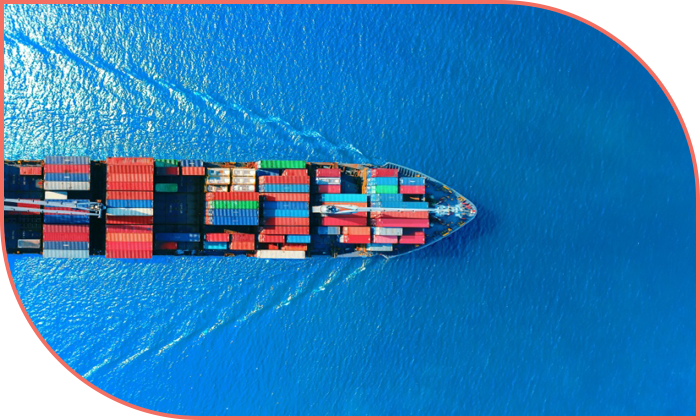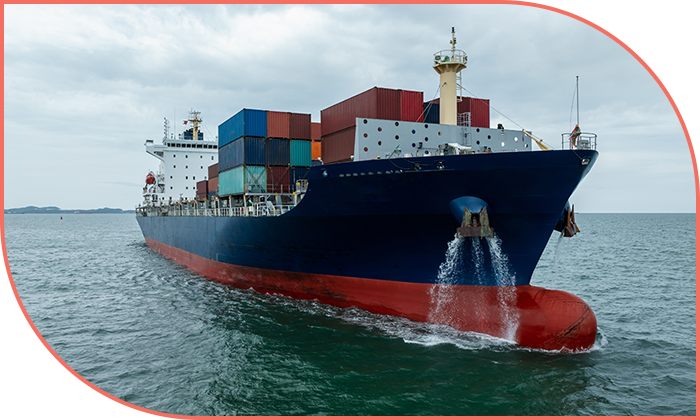FCL Shipping
What does FCL stand for?
The term FCL stands for ‘full container load’ and describes a method of container shipping.
What is the definition of FCL?
FCL shipping is where an entire container is used exclusively for a single shipment.
The shipper has the entire container space at their disposal without sharing it with other shippers' cargo. FCL cargo is sealed at the point of origin and remains untouched until it reaches its destination.
What are the benefits of FCL shipping?

Faster than LCL
Full container load shipping offers significant time savings compared to LCL (Less than Container Load) shipping.
Since an entire container is dedicated to one shipment, it bypasses the need for consolidation and deconsolidation at various ports.
Cheaper than air freight
When considering cost-efficiency for large shipments, FCL is generally cheaper than air freight.
Although air freight offers the fastest delivery times, it comes at a premium cost. FCL freight, on the other hand, provides a flat fee for the entire container, meaning it can often be more economical for transporting large volumes of goods.
Reduced risk of damage
Since a single shipper uses the entire container, there is less handling involved compared to LCL shipments (where multiple shippers' goods are combined).
Reduced handling decreases the chances of damage caused by loading and unloading processes. Plus, having exclusive use of the container minimises the risk of contamination or damage from other shippers' goods.
Excellent for shipping large volumes of goods
FCL is particularly well-suited for shipping large volumes of goods.
It offers substantial cost savings on a per-unit basis when the container is fully utilised. The standard container sizes (20-foot and 40-foot) provide ample space for large quantities of cargo.

Compare Freight Shipping Rates in Seconds
Get instant quotes from leading ocean and air freight providers. Find the best rates for your shipping needs in one place.
What are the drawbacks of full container load shipping?

Costly for smaller loads
FCL freight shipping can be cost-prohibitive for smaller loads. Since you pay for the entire container regardless of how full it is, shipping smaller quantities can result in higher costs per unit.
Slower than air freight
While FCL delivery is faster than LCL (due to less handling and direct routes), it is still slower compared to air freight.
FCL ocean freight involves longer transit times due to the nature of ocean travel and customs clearance. Air freight, however, is more suitable for time-sensitive shipments as it offers the quickest delivery times.
FCL shipping costs
Holiday delays
Major holidays such as the Chinese New Year and Golden Week in China cause significant disruptions to FCL ocean freight.
During these periods, there is typically a surge in demand for shipping services, which can lead to congestion at ports and delays in transit times.
These holidays often result in factories shutting down, leading to a backlog of shipments that need to be processed before and after the holiday period.
GRIs (General Rate Increases)
General Rate Increases (GRIs) are periodic adjustments in shipping rates implemented by carriers to account for market demand and supply dynamics.
These increases are typically announced at the beginning and middle of each month and can significantly impact the cost of full container load shipping.
Peak seasons
Peak seasons in the shipping industry, particularly from August to November, coincide with the preparation for major retail events like Black Friday and the Christmas holiday season.
During these times, the demand for shipping services spikes as businesses rush to stock up on inventory. The surge in demand leads to higher freight rates due to the increased competition for available container space.
Get The Best Freight Rates Today
Easily compare rates from top ocean and air freight carriers. Save time and money on your next shipment.
What is involved in the FCL shipping process?

The FCL (Full Container Load) shipping process begins with selecting the appropriate container size based on your shipment volume.
Your goods are loaded into the container at the supplier's location, where it is sealed and then transported to the port.
After clearing customs, the container is loaded onto a vessel for its journey to the destination port. Upon arrival, the container undergoes customs clearance and is then delivered to your specified location.
How long does FCL shipping take?
The transit time for full container load shipping varies based on the origin and destination, as well as the shipping route. Generally, FCL shipments can take anywhere from a few weeks to over a month.
Should I get a tender for FCL shipping?
Obtaining a tender for full container load shipping can be beneficial if you regularly ship large volumes (e.g., over 500 annual TEUs).
A tender allows you to lock in rates with a carrier or freight forwarder over a specified period, providing cost predictability and potentially lower rates due to committed volumes.
Is FCL right for me?
FCL shipping is ideal if you have enough goods to fill a container, or if you require the added security and reduced handling that comes with exclusive container use.
Get an FCL shipping quote with Freight Brokers, and find out more about the costs of shipping goods overseas.
What is the procedure for delivery and unloading at my warehouse?
When it comes to FCL freight, live and drop unloading are the main types of warehouse deliveries.
Live unloading
In a live unloading scenario, the container arrives at your warehouse, and you have a specified time (usually around three hours) to unload the contents.
Live deliveries require adequate manpower and equipment, such as forklifts, to efficiently unload the goods within the allotted time frame. After unloading, the empty container is returned to the port for reuse.
Drop unloading
With drop unloading, the container is left at your premises for a longer period, allowing for more flexible unloading.
Drop deliveries can be beneficial if you lack the immediate resources to unload quickly. However, it may incur additional charges for extended use of the container.
Find The Lowest Freight Rates Today
Compare shipping quotes from trusted providers. Get the best deals for ocean or air freight.